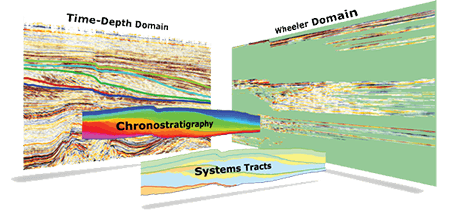SSIS is an add-on to the HorizonCube.
Product Overview
SSIS supports Wheeler transformations and sequence stratigraphic (systems tracts) interpretations based on chrono-stratigraphic horizons from the HorizonCube. The HorizonCube consists of a set of densely sampled 2D or 3D horizons that follow seismic events. Each horizon in the HorizonCube represents a (relative) geologic time line. With the HorizonCube slider we can interactively add/remove chrono-stratigaphic horizons from a display of a seismic section. In that way we can reconstruct the history of deposition in (relative) geologic time. This tool is also extremely useful in cross-correlating events between wells (see Well Correlation Panel plugin).



Product description
The Wheeler transformation is another key feature of OpendTect SSIS. A Wheeler transformation is a flattening of seismic data according to the calculated chrono-stratigraphy. In the Wheeler domain we see when (in relative geologic time) and where (spatially) events were deposited, how the depositional center shifted over time (basin-wards or landwards) and how events are related in time. Gaps in the Wheeler domain are caused either by erosion or non-deposition
Wheeler transformed seismic volumes (and attribute volumes) have another important use. A time-slice in this domain shows stratigraphic features that were deposited at the same geologic time. Time-slicing in this domain is equivalent to horizon-slicing in the structural domain. So, by movie-style time-slicing in the Wheeler domain we can visualize stratigraphic details that are not obscured by structural deformation!
OpendTect SSIS supports an interpretation module for systems tracts interpretation and to extract important stratigraphic boundaries from the interpreted data. The module automatically reconstructs the relative base level curve and supports all popular sequence stratigraphic models used in the industry.